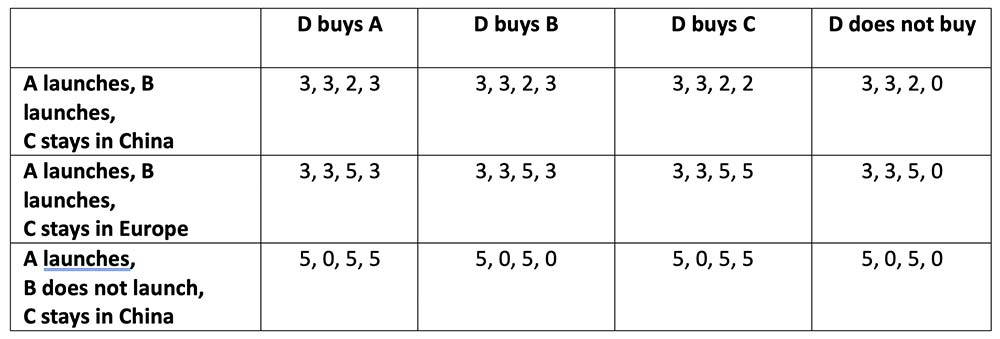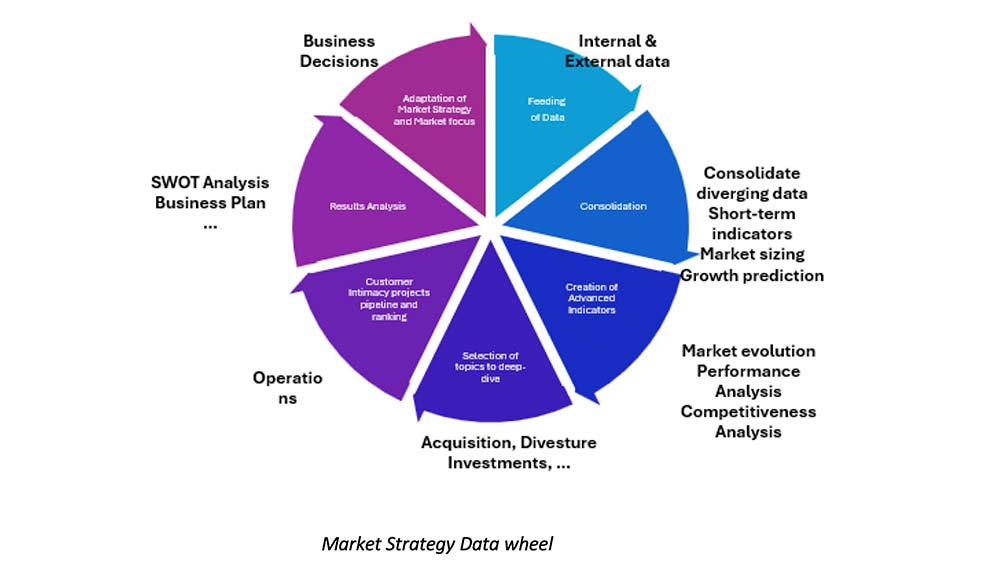
Why is Game Theory essential in B2B strategic management?
Because the number of unknowns, their mutability and their intensity are such that game theory is one of the best ways to show the necessity of having structured management of knowledge and predictive tools in order to the finaqualifyl decision.
Originally, B2B Market Strategy in the industry encompasses all contexts, objectives, action plans and schedules, expected results, and resources to be implemented for the development of an innovation (new products, technologies, market segments, new geographic area, etc.) that it rationalizes:
The elements of a B2B Market Strategy include, for example:
- Definition of the scope (Technologies, etc.), objectives, and strategic intents
- Knowledge of markets, their potentials, their possible evolutions, drivers
- Modeling and forecasting
- Deduction of impacts
- Business Case and Business Plan
Today, the increasing complexity of flows is a major factor in B2B Market Strategy, which requires rethinking it.
Building a robust Market Strategy results from the reprocessing of a set of increasing complexities from various directions, including human, financial, and technological investments:
- Unstable geopolitical context impacting supplies, raw material costs, energy costs, market openings/closures…
- Strong growth of new market elements (e.g., sustainability, recycling…)
- Rapid evolution of technologies (e.g., recycling technology…)
- Rise of new industrial players ((*) see below: out of the Top 499 worldwide Chemical companies, 30% are Chinese – 152/499)
Beyond events that we can consider as ‘Brownian’, what are the long-term developments we can rely on, and with what margins of uncertainty?
Our missions in Specialty Chemicals, Materials, Ingredients, and Biotechnologies in EMEA, the Americas, and APAC have allowed us, over our 25 years of experience, to develop, test, and consolidate our methodological expertise and tools.
We would like to illustrate here these methodological elements and the tools we use in a B2B Market Strategy project, through an example: the Strategy of Games.
Table of content
1) Step 1 : Define the context, objectives, strategic intentions
2) Step 2 : Decisions to be made and assumptions.
3) Step 3 : Games theory & Results
4) Conclusion
5) Daydream: B2B Tailor-made Projects in EMEA / APAC / AMERICAS
Step 1
Step 1, which is crucial, is to define the context, objectives, strategic intentions, and therefore the questions that need to be answered.
Therefore, it is necessary to establish the assumptions and strategic intentions within a specific context.
For example:
- Company A: Invests in R&D to develop a new chemical recycling technology in Europe
- Company B: Already has chemical and physical recycling technology
- Company C: Has both technologies in China
- Company D: Has a strong investment capacity and is considering acquiring A, B, or C.
Method & Tools: Methodological expertise requires the ability to:
- Define the context, objectives, and questions and sub-questions (see Pyramid Principle)
- Within the framework of proposals and projects
Step 2 : Define the decisions to be made and thus the working hypotheses
To simplify, the decisions to be made can be:
- Company A: Launch or not launch its technology following its R&D program
- Company B: Launch or not launch its technology
- Company C: Develop new business in Europe with its current technology
- Company D: Acquire A, B, C, or do nothing
Hypotheses
- If A and B launch their technology, they obtain the same market share, and their respective profits decrease.
- If A launches its technology and B does not: A gains a competitive advantage.
- If B launches its technology and A does not: B gains a competitive advantage.
- If C decides to launch its technology immediately (in China or Europe), it maximizes its profits as there is no immediate competition in the short term.
- D evaluates the acquisition based on the potential post-acquisition benefits
Method & Tools:
Formulating these hypotheses pertinently and knowing how to address them requires an in-depth understanding of the technologies, competition, and market evolution, which is built by:
- Structured knowledge capitalization, both qualitative and quantitative, within the Group. We often observe that:
- Knowledge is often dispersed within the Group
- Data is not updated
- Available “multi-client” studies are often approximate
- The average market estimates provide a very approximate or even false value of reality
- Numerous influencing factors modify “linear” forecasts…
- Organized inquiry of knowledge: “Primary Research” from experts and operational actors provides more precise elements on the current situation and probable developments.
- Periodic updating of internal and external data
- Use of Mathematical Modeling tools that build key results (Real Option, Monte-Carlo).
Step 3 : Game Theory & Results
In our example, and assuming D decides on Companies A, B, or C, the game strategy is organized as follows:
- Before Acquisition by D
- After Acquisition by D
Before Acquisition by D, the values representing potential gains (from 5 max to 0 min) for each company in the order A, B, C, D are as follows:

After Acquisition by D:
- D buys A: D obtains the benefits of A
- D buys B: D obtains the benefits of B
- D buys C: D obtains the benefits of C
- D does not buy: D does not gain any additional benefits.

Conclusion
The results of a simple game (4 players at a given time) show that:
- The winners are those who invest and take risks.
- Only forecasts based on in-depth and structured knowledge of markets, competition, influencing factors, and competitors can enable the definition of a Strategy and Business Plan.
- With our extensive experience, we can support you in the personalized construction of your Market Strategy, implementing tools and methodologies adapted to your objectives.

Daydream: B2B Tailor-made Projects in EMEA / APAC / AMERICAS
We have led many tailor-made B2B projects in EMEA / APAC / AMERICAS some of them in a very complex environment in the B2B industry throughout the manufacturing value chain from raw materials to products.
Since 2000, we have proven offers in:
- Market & Business Strategy
- New Business Development
- Sustainability
- Digitalization, Methodology & Tools
(*) Illustration: TOP499 Chemicals companies (Daydream data) 2022 by region










